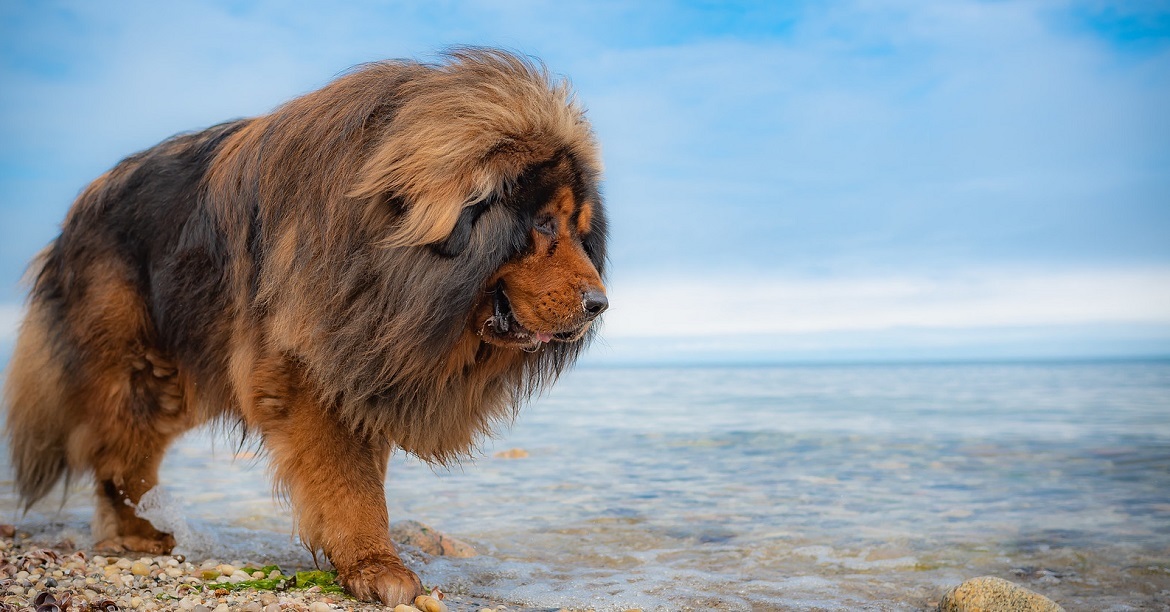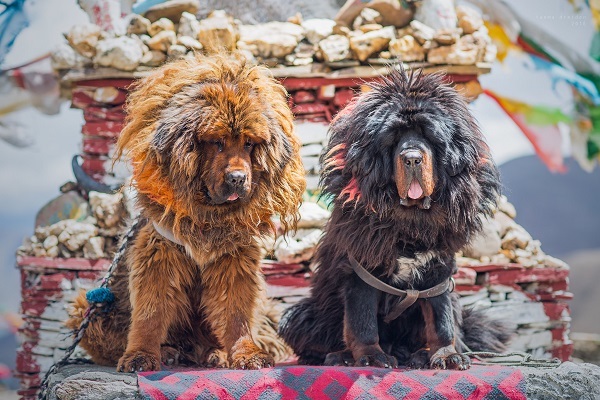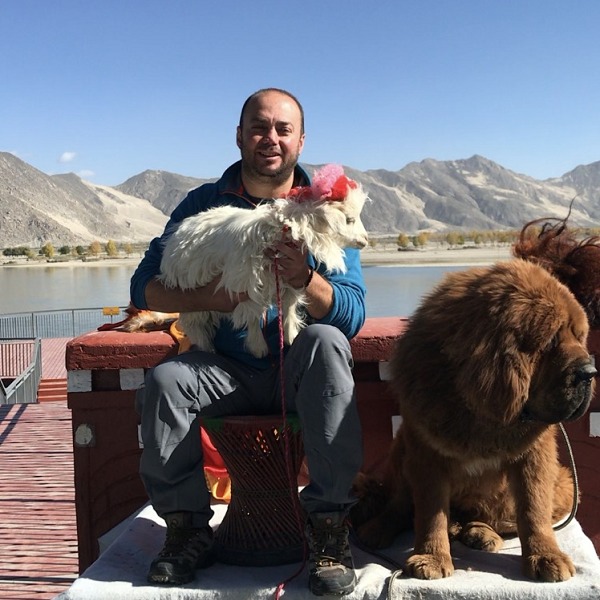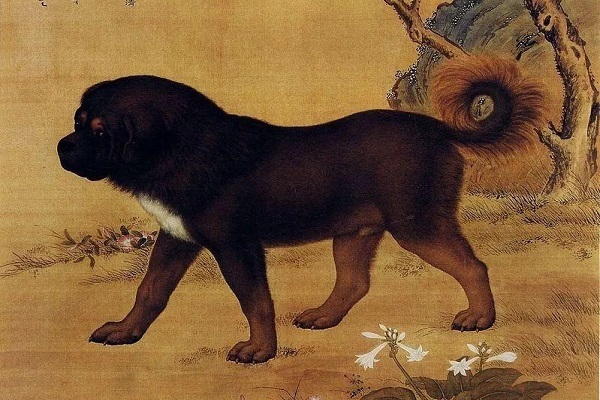Tibetan Mastiff
- Eric
- Last Updated : 07/06/2025

The Tibetan Mastiff, belonging to the mastiffs, is a large and fierce dog. It is one of the world's most ancient breeds, and over 2000 years ago, it was active in the Himalayas and the alpine regions of the Tibetan Plateau at elevations of 3000-5000 meters. Due to its loyal nature, the breed became a prized protection dog for both nomads and kings. According to Tibetans, in pastoral areas, one adult Tibetan mastiff can guard 400 sheep, defeat three evil wolves, and make leopards show the white feature, earning it the title of Heavenly Dog. After Westerners witnessed the breed’s strength, they called it the “Oriental Supernal Dog.” In Nepali, it's known as Bhote Kukur (meaning Tibetan dog), and in Mongolian, it's called Bankhar (meaning lion).
The Tibetan Mastiff plays a very important role in the improvement of many famous dogs, such as St. Bernard, Great Dane, Komondor, and Newfoundland, as well as various mastiffs, which have the blood of Tibetan Mastiff. However, due to the special living environment of the plateau and the herdsmen's weak consciousness of bloodline protection over the years, partial original Tibetan mastiffs have merged with the local shepherd dogs, resulting in fewer and fewer pedigree Tibetan mastiffs.
Profile

- Lifespan: 12–15 years
- Avg height: The shoulder height of the male dogs are at a minimum of 66cm, and the females are at a minimum of 62 cm
- Avg weight: 55-80kg
- Coat colours: black, brown-red, black and tan, white, and grey
- Litter Size: 5-12 puppies
- Temperament: Protective, strong willed, stubborn, courageous, dignified, loyal
Appearance
A pedigree adult Tibetan Mastiff weighs about 60 kg and is about 1.2 m long and 66 cm high. It has a thick coat of fur, strong muscles, strong limbs and torso and full of strength, a long tail lifted high or bent to one side, and four-point eyes (yellow or white dots on the eyebrows). Interestingly, under cold weather conditions, the fur is thick and soft as wool, resistant to cold, and can sleep peacefully in ice and snow; however, in warm weather conditions, the fur is very rare.
Purebred Tibetan Mastiffs are most commonly seen in the vast pastoral areas. According to the lineage, the Tibetan Mastiff is roughly divided into two types: lion head and tiger head. The lion head's skull is small and the nape hair is long while the tiger head's skull is large and the nape hair is short. The coat colors include fire mastiff (brown-red), snow mastiff (pure white), Black & Tan (black back and red hoof), yellow mastiff (golden), and black mastiff (black is not pure black, but slightly white hair on the chest and limbs).
Among these, red-brown and pure white are considered rare and precious. The black back and yellow belly coloration is more common, constituting approximately 70%, with the variant of black back and red-brown belly being the most prized. Wolf-gray Tibetan Mastiffs are renowned for their large size and fierce temperament.
Character Features
The real Tibetan Mastiff has the dignity of a king. The harsh plateau environment not only fosters strong willpower but also shapes its king-like temperament. It is lonely and arrogant, mighty and brave, noble and elegant, loyal and dedicated. The breed’s endurance to hunger, cold, and resistance to hardships are among its most attractive traits. As a result, these dogs are skilled at protecting territory, guarding food, and acting aggressively when needed. In its territory, the Tibetan Mastiff is hostile to strangers but loyal and extremely affectionate toward its owner. As a guard dog, it is faithful and reliable.
Personality
 No matter how fierce it is, Tibetan Mastiff has always maintained absolute loyalty to its master. Besides, it is difficult for anyone else to approach. Another personality of the large dog breed is that, like a tiger, it is unwilling to be touched by its tail, which can easily irritate it. Puppies and young mastiffs, especially those under 3 years of age, can be surprisingly destructive. Tibetan Mastiff has a particularly strong bite force. They know how to "open the way with their mouths" to pass through doors and iron fences, so when building a kennel, you must pay attention to the sturdiness.
No matter how fierce it is, Tibetan Mastiff has always maintained absolute loyalty to its master. Besides, it is difficult for anyone else to approach. Another personality of the large dog breed is that, like a tiger, it is unwilling to be touched by its tail, which can easily irritate it. Puppies and young mastiffs, especially those under 3 years of age, can be surprisingly destructive. Tibetan Mastiff has a particularly strong bite force. They know how to "open the way with their mouths" to pass through doors and iron fences, so when building a kennel, you must pay attention to the sturdiness.
Many Tibetan mastiffs like children, but strange children often arouse their ferocious instincts, because they don't understand that children's normal running, jumping, playing and screaming are not aggressive behaviors. So be careful not to let children come into contact with them alone. The Tibetan Mastiff has a high IQ and a very independent personality. They usually do not have good obedience and activeness, as well as do not like to participate in organized activities.
Health Concerns
The average life expectancy of the dogs is 12 - 15 years, though some may live longer with proper care. Certainly, it’s closely tied to factors like environment, diet, and feeding. Health concerns include:
- Thyroid Disease: Affects up to 30% of the breed.
- Cardiovascular Issues: Genetic predisposition requires regular exercise and a controlled diet.
- Ocular Problems: Prone to corneal ulcers and eyelid drooping; regular cleaning and vitamin A supplementation help prevent issues.
- Orthopedic Diseases: Conditions like hip and elbow dysplasia are common. Regular veterinary check-ups are recommended.
Caring for Tibetan Mastiff
Tibetan Mastiff needs to change its hair at least once a year (sometimes twice). During hair removal, it is best to comb it every day to stimulate the cortical glands and speed up hair removal. Remember that the Tibetan Mastiff is a huge dog, and it takes 4 weeks for it to fully shed its undercoat.
For male and female dogs over 8 months of age, it’s important to isolate them to prevent illegal or early mating, which can affect their continued growth. Allowing immature males and females to mate on their own is not ideal for their development and temperament. Male Tibetan mastiffs, in particular, may have irritable temperaments, unstable personalities, and aggressive behavior.
History
 The Tibetan Mastiff has a history of thousands of years and is the oldest dog breed. It was used as a guard dog since the Spring and Autumn Period (771 BC - 476 BC). According to the records, the nomadic people(Qiang) at that time domesticated the wild dogs in order to cope with attacks and threats from other beasts. This should be the prototype of the earliest Tibetan mastiff. In the extremely harsh living environment on the Tibetan Plateau, the herders chose individuals who were large and robust, fierce and loyal, and good at herding animals to breed their offspring. The Italian painter Castiglione drew pictures of "Ten Dogs" in accordance with Emperor Qianlong's will, and the last one is “Cang Ni”, which is a Tibetan mastiff.
The Tibetan Mastiff has a history of thousands of years and is the oldest dog breed. It was used as a guard dog since the Spring and Autumn Period (771 BC - 476 BC). According to the records, the nomadic people(Qiang) at that time domesticated the wild dogs in order to cope with attacks and threats from other beasts. This should be the prototype of the earliest Tibetan mastiff. In the extremely harsh living environment on the Tibetan Plateau, the herders chose individuals who were large and robust, fierce and loyal, and good at herding animals to breed their offspring. The Italian painter Castiglione drew pictures of "Ten Dogs" in accordance with Emperor Qianlong's will, and the last one is “Cang Ni”, which is a Tibetan mastiff.
However, whether in early modern times or in contemporary periods, it was Westerners who first recognized the breed’s value and promoted it. In the early 18th century, the British began cultivating Tibetan Mastiffs and established pedigree records. In 1947, the breed was first brought to America. In 1973, the United States established the American Tibetan Mastiff Conservation Association to better protect, understand, and breed this endangered dog, initiating efforts to preserve, research, and classify it.
Conclusion
The Tibetan Mastiff is a majestic and loyal breed with a rich history and significant influence on modern dog breeds. While they require careful handling and dedicated care, their loyalty and protective nature make them invaluable companions for those who can meet their needs.
Email response within 0.5~24 hours.







